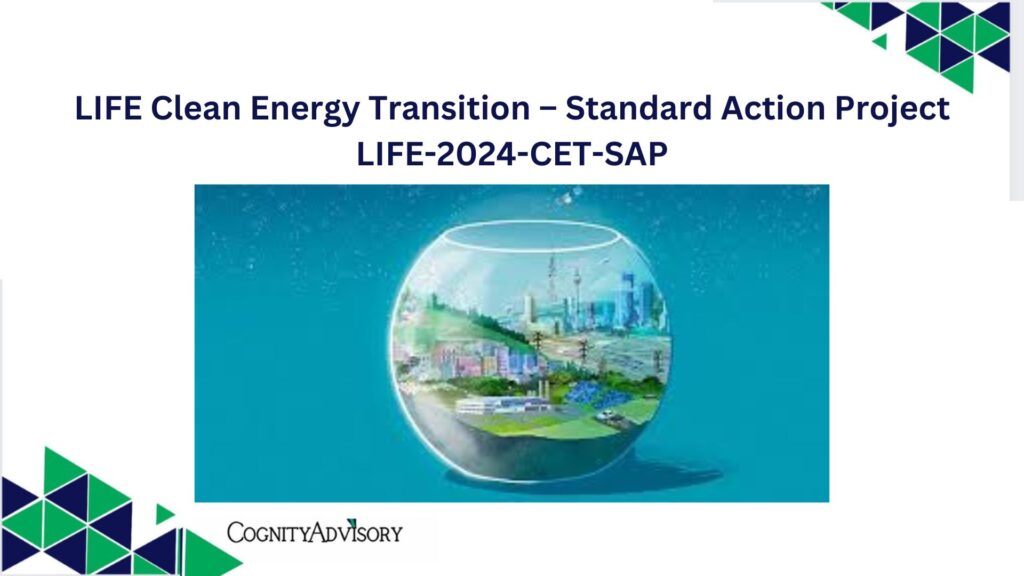LIFE-2024-CET-SAP
General information
Programme
Programme for Environment and Climate Action (LIFE)Budget overview
Call
LIFE Clean Energy Transition (LIFE-2024-CET)
Type of action
LIFE-PJG LIFE Project Grants
Type of MGA
LIFE Action Grant Budget-Based [LIFE-AG]
Open For Submission
Deadline model
single-stage
Opening date
18 April 2024
Deadline date
19 September 2024 17:00:00 Brussels timeTopic description
Objective:
This topic aims to complement the main Coordination and Support Actions (CSAs) under the LIFE Clean Energy Transition work-programme 2024, with a Call for LIFE Standard Action Projects (SAPs), co-financing action in the area of the clean energy transition with up to 60% of the eligible costs specifically addressed to support bottom-up actions by key actors of the EU energy transition.
SAPs are a flexible tool available to support actions from key commercial and non-commercial actors of the EU energy transition, which includes entities from all sectors (public, non-governmental and private). They are preferably close-to-market (i.e. aimed not only at delivering improved clean energy solutions, but also at making sure such solutions are widely taken up by society in general and, more particularly, by the economy through an explicit market-oriented approach). In this case, applicants will be required to highlight specific market-related information in their application (e.g. planned production capacity, reference market, economic feasibility etc.).
Actions under this topic should contribute to the implementation of the EU’s energy efficiency and renewable energy policy and legislation and demonstrate their positive contribution to the overall clean and fair energy transition.
This topic aims to support actions from key commercial and non-commercial actors in the clean energy transition, involving in particular local and regional authorities, energy agencies, energy service companies (ESCOs), financial institutions and EU manufacturers of net-zero energy technologies.Scope:
The focus of the actions under this Call should address one of the following areas:
- Support local and regional authorities in establishing new energy agencies to support the delivery of the clean energy transition on the ground, including synergies with other areas addressed by the LIFE Programme and contributing to a carbon neutral future;
- Support energy service companies (ESCOs) in piloting and rolling-out ambitious investment and financial solutions for deep energy renovation of buildings, such as EnPC or similar contractual arrangements.
- Support financial institutions, brokers, insurers and other actors involved in the energy financing areas, as well as public-private partnerships, in developing and marketing financial products and solutions to finance investments in energy efficiency and integrated renewables.
- Support EU manufacturers of net-zero energy technologies to roll-out innovative techniques, including activities such as the identification of needs for regulatory updates where relevant (e.g. regulatory sandboxes), along with fostering collaboration with all actors in the value-chains to increase the market uptake and large-scale deployment of their clean energy solutions in line with the Green Deal Industrial Plan and the Net-Zero Industry Act.
Proposals should address one of the above listed points. Addressing more than one point does not increase the relevance of the proposal.
Actions should provide the right mix of activities that will ensure their sustainability and replicability after LIFE CET support.
Proposals may be submitted by a single applicant from a single eligible country.
The Commission considers that proposals requesting a contribution from the EU of up to EUR 1.5 million would allow the specific objectives to be addressed appropriately. Nonetheless, this does not preclude submission and selection of proposals requesting other amounts.Expected Impact:
Proposals should present the concrete results which will be delivered by the activities and demonstrate how these results will contribute to deliver impact on the relevant markets and stakeholders. This impact should be quantified with indicators which are specific to the proposed activities. Proposals should include a detailed analysis of the starting point and a set of well-substantiated assumptions and establish clear causality links between the results and the expected impacts. The results and impacts should be quantified for the end of the project and for 5 years after the end of the project.
Proposals should also quantify their impacts (when relevant) against the following common indicators for the LIFE Clean Energy Transition subprogramme:
- Primary energy savings triggered by the project in GWh/year.
- Final energy savings triggered by the project in GWh/year.
- Renewable energy generation triggered by the project (in GWh/year)
- Reduction of greenhouse gases emissions (in tCO2-eq/year).
- Investments in sustainable energy (energy efficiency and renewable energy) triggered by the project (cumulative, in million Euro).
- Number of pieces of legislation, policies or strategies created/adapted to support sustainable energy policies.
- Number of products (goods or services), processes and methods launched into the market by the project.
- Number of real-life implementation sites carried out by the project.
- Number of market stakeholders trained with increased clean energy transition skills and competencies due to the project.
- Number of stakeholders reached through events and media during the project.
- Number of jobs created in full-time equivalent (FTE).
